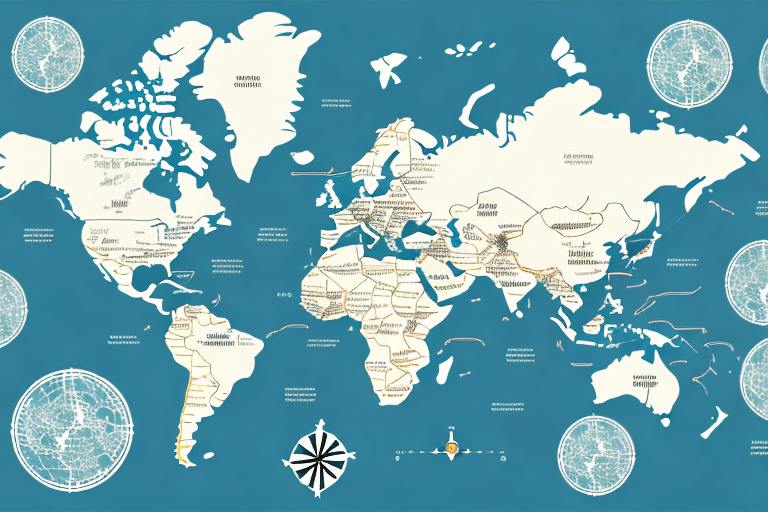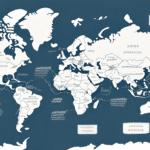Understanding UPS Shipping Zones and How They Affect Your Shipping Costs
For businesses that regularly ship products to customers or partners, understanding the intricacies of shipping carriers is crucial. UPS, one of the leading shipping carriers globally, plays a significant role in determining shipping costs. A key factor in this calculation is the concept of shipping zones.
What are UPS Shipping Zones?
UPS Shipping Zones are geographical regions that the United States is divided into for the purpose of calculating shipping rates. The U.S. is segmented into 8 primary zones, with Zone 1 being the closest to the shipper's location and Zone 8 being the farthest. Additionally, UPS designates specific zones for Alaska, Hawaii, and international destinations.
Understanding UPS Shipping Zones is essential for businesses that ship to various parts of the country. Accurate knowledge of these zones enables businesses to calculate shipping costs precisely and adjust their pricing strategies accordingly. UPS offers a range of shipping options within each zone, including ground, air, and international services, allowing businesses to select the most cost-effective and efficient method for their needs.
It’s important to note that UPS Shipping Zones are dynamic and can change over time due to factors like transportation infrastructure development, population growth, and economic changes. Therefore, businesses should regularly review their shipping strategies to stay updated with any adjustments in UPS Shipping Zones.
How are UPS Shipping Zones Determined?
UPS Shipping Zones are primarily determined based on the distance between the origin and the destination of the package. For instance, Zone 1 covers packages shipped within 150 miles of the origin, while Zone 8 includes packages that need to travel over 1,800 miles.
Additional Factors Influencing Shipping Zones
- Transportation Infrastructure: The quality and availability of transportation routes can affect zone boundaries.
- Traffic Patterns: High-traffic areas might influence the efficiency of shipping routes.
- Regional Regulations: Local laws and regulations can impact shipping logistics.
UPS regularly updates its shipping zone maps to reflect changes in transportation routes and infrastructure. Therefore, it’s essential to consult the most current zone map when planning shipments.
The Importance of Knowing Your Shipping Zone
Understanding your shipping zone is critical for determining the cost of shipping your packages. Higher shipping zones typically incur higher shipping costs. By being aware of your shipping zone, you can make strategic decisions regarding carrier selection and packaging to optimize costs.
Impact on Delivery Times
Different shipping zones can affect delivery times. Knowing your zone helps in accurately estimating when a package will arrive, which is vital for time-sensitive shipments and maintaining customer satisfaction.
How to Determine Your Shipping Zone
There are several methods to determine your UPS shipping zone:
- UPS Zone Calculator: Use the online UPS Zone Calculator by entering the origin and destination ZIP codes.
- Contact UPS: Reach out to UPS directly for assistance in determining your shipping zone.
- Shipping Software: Utilize shipping software that integrates UPS shipping zone information.
Accurately determining your shipping zone helps in planning and optimizing your shipping strategy for cost-effective and timely deliveries.
Strategies to Save on Shipping Costs with UPS Zones
Businesses can implement various strategies to reduce shipping costs associated with UPS zones:
Consolidate Shipments
Shipping in larger quantities can reduce the frequency of shipments and overall costs.
Negotiate Rates
Leverage your shipping volume to negotiate better rates with UPS.
Zone Skipping
Use UPS's zone skipping service to bypass certain zones and ship directly to a destination zone, potentially saving costs.
Choose Appropriate Shipping Options
Select slower shipping options or alternate carriers when appropriate to cut expenses.
The Impact of Distance on Shipping Costs
The distance between the origin and destination of your package significantly influences shipping costs. Longer distances typically result in higher costs and longer delivery times. To mitigate these expenses, consider sourcing products closer to your customer base or selecting carriers that offer better rates for longer distances.
Additional Cost Factors
- Package Weight and Size: Heavier and larger packages incur higher shipping costs.
- Delivery Speed: Faster delivery options cost more.
Negotiating Better Rates with UPS
Negotiating favorable rates with UPS can lead to substantial savings for businesses that ship frequently:
Discuss Your Shipping Volume
Meeting with a UPS representative to discuss your shipping volume can open opportunities for rate reductions.
Use a Shipping Consultant
A third-party shipping consultant can assist in negotiating and identifying cost-saving opportunities.
Optimize Shipping Options
Select the most cost-effective shipping options that align with your business needs.
The Role of Package Weight in UPS Shipping Zones
Package weight directly impacts shipping zones and costs. Heavier packages result in higher shipping expenses. Accurately weighing packages and selecting appropriate packaging can help in reducing costs and qualifying for lower rates.
Impact on Delivery Time
Heavier packages may require additional handling, potentially extending delivery times. Choosing the right shipping method based on package weight ensures timely delivery.
Common Misconceptions About UPS Shipping Zones
There are several misconceptions regarding UPS shipping zones:
- Zones are Based Solely on Zip Codes: In reality, UPS uses a complex algorithm considering distance, package weight, and size.
- Shipping Zones are Static: Zones can change based on UPS's network and transportation route updates.
Additionally, different UPS services like UPS Ground and UPS Next Day Air have distinct zone boundaries and rate structures. It's crucial to review shipping options and associated costs carefully.
Factors That Affect UPS Shipping Zones
Beyond distance and weight, several factors influence UPS shipping zones and costs:
- Package Contents: Fragile or hazardous items may incur additional fees.
- Packaging Materials: The type and quality of packaging can affect costs.
- Fuel Surcharges: Fluctuations in fuel prices can impact shipping rates.
- Seasonal Demand: High shipping seasons may lead to increased costs.
Remote or hard-to-access delivery locations can also result in additional fees or longer delivery times. Additionally, the timing of package drop-offs can affect processing times and costs.
Optimizing Your Shipping Strategy Using UPS Zones
Optimizing your shipping strategy with UPS zones can lead to significant cost savings:
- Consolidate Shipments: Reduce the number of shipments by sending larger, consolidated packages.
- Select Appropriate Packaging: Use packaging that is cost-effective and meets UPS requirements.
- Negotiate Rates: Engage with UPS representatives to secure better rates based on your shipping volume.
- Source Locally: Reduce shipping distances by sourcing products closer to your customer base.
- Leverage Third-Party Logistics: Utilize third-party logistics providers to streamline shipping processes and identify cost-saving opportunities.
Understanding the Difference Between Residential and Commercial Zones
UPS distinguishes between residential and commercial zones, each with different rates and requirements:
Residential Zones
These zones cover primarily residential areas such as homes and apartments. Shipping to residential zones may incur higher rates due to the complexity of delivery routes.
Commercial Zones
Commercial zones include business-oriented areas like office buildings and industrial parks. Shipping to commercial zones often benefits from more efficient delivery routes, potentially lowering costs.
Understanding the distinction between these zones is essential for accurately calculating shipping costs and selecting the most appropriate service.
Using UPS Shipping Zones for International Shipments
When shipping internationally, UPS shipping zones become more complex, taking into account factors such as trade agreements, customs regulations, and exchange rates. To effectively manage international shipments:
Work with a Shipping Consultant
A trusted shipping consultant can help navigate the complexities of international shipping zones and ensure compliance with all regulations.
Stay Informed on Trade Agreements
Understanding current trade agreements can help optimize shipping routes and costs.
Utilize UPS International Services
UPS offers various international shipping services tailored to different needs and budgets.
Best Practices for Managing UPS Shipping Zones
Implementing best practices can enhance the efficiency and cost-effectiveness of your shipping strategy:
- Regularly Audit Shipping Costs: Ensure you are receiving the best possible rates by conducting periodic audits.
- Partner with a Shipping Consultant: Gain expert insights to identify cost-saving opportunities.
- Continuously Optimize Your Strategy: Adjust your shipping approach based on changes in your business operations and the shipping industry.
By effectively managing UPS Shipping Zones, businesses can optimize their shipping strategies, reduce expenses, and enhance overall profitability.






















